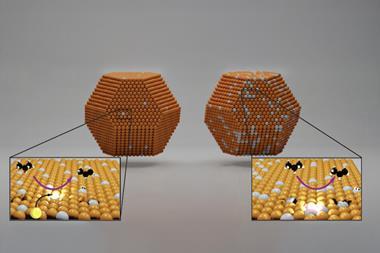Scientists in Japan have made a groundbreaking discovery: they have identified a covalent bond between two carbon atoms that share only a single electron. ‘This [study was driven] by a curiosity to know where the limits of chemical bonds are,’ says Takuya Shimajiri at the University of Tokyo.

One-electron bonds were first proposed in 1931 by Linus Pauling and have since been reported between heteroatoms. However, no direct evidence of their existence between carbon atoms had ever been observed. ‘We came up with the idea that it would be possible under the proper molecular design,’ says Shimajiri.
The sharing of electron pairs serves an important purpose: it fills an atom’s outer shell of electrons to make it more stable. With one crucial electron missing, one-electron bonds are understandably much weaker and, therefore, break down quickly. As such, they have only been proposed to exist transiently as intermediates in chemical reactions.
‘To tackle this issue, we adopted the intramolecular core-shell strategy, which protects a weak bond (core) by surrounding it with a rigid π-skeleton (shell),’ explains Shimajiri. The stabilising skeleton was composed of electron-rich hexaphenylethane derivatives, which lose electrons during an oxidation reaction to form charged carbocations and radicals.
Although two electrons are lost during this oxidation, resulting in two triarylmethyl cations, the reaction is considered ‘one step’ because it occurs so quickly. However, the team reasoned that if they could control the sequence of steps, they could trap a carbon radical that forms when a carbon–carbon bond within the hexaphenylethane molecule breaks during the reaction. This break produces a carbon atom with an unpaired electron, which, under the right conditions, could be shared with its neighbouring carbon to form the elusive one-electron bond that is stabilised by the rest of the molecule.
To achieve this, the scientists took advantage of the elongated carbon–carbon bond within hexaphenylethane, caused by the bulky aryl groups attached to it. This elongation changes the electronic properties of the molecule, making the energy gap between orbitals in crucial intermediate species big enough that the reaction does not occur as quickly. Instead, it can be slowed to a step-by-step mechanism, allowing the scientists to trap the carbon radical that forms the one-electron bond.

‘The strategy … involves stretching the bond in the parent molecule and tuning the energies of the molecular orbitals,’ says Cate Anstöter, a research fellow at the University of Edinburgh who was not involved in the study. ‘It’s a real testament to the elegant chemical engineering.’
‘Combining synthetic with spectroscopy with computational chemistry and century old theory, is an elegant example of what can happen when different subfields of chemistry have a shared synergy,’ adds Philip Camp at the University of Edinburgh who was also not involved in the study.
This new bond also challenges our fundamental understanding of what exactly constitutes a covalent bond. ‘Roughly speaking, the cause of this bond is the proximity of the atoms due to the rest of the molecule, not the other way around,’ says Camp. ‘It has not been demonstrated that it satisfies the [International Union of Pure and Applied Chemistry] definition.’
But according to Shimajiri, this is kind of the point. ‘We aim to clarify what a covalent bond is – specifically, at what point does a bond qualify as covalent and at what point does it not? Our goal is to explore a wide range of bonds that have yet to be discovered, not just between carbon atoms, but between all elements.’
‘While there have been other examples of this bonding motif, this study in particular has the potential to unlock a new field of study due to the bond being between two carbon centres,’ says Anstöter. ‘As carbon is ubiquitous in the known universe, teaching this element a new trick peaks interest in a diverse range of research areas from fundamental theory to applied materials.’
References
T Shimajiri et al, Nature, 2024, DOI: 10.1038/s41586-024-07965-1

















1 Reader's comment